From a Low-Cost Air Quality Sensor Network to Decision Support Services: Steps towards Data Calibration and Service Development
Abstract
1. Introduction
2. Background and Motivation
2.1. Air Quality Data Pipeline
2.2. Application Domain: Air Quality Pilot in Trondheim
2.3. Low-Cost Sensor Network in Trondheim
3. Data Calibration
3.1. Datasets
3.2. Single Sensor Calibration
3.2.1. Method
3.2.2. Results
3.3. Hyperlocal Prediction of Air Pollutants
3.3.1. Method
3.3.2. Results
4. Applications
4.1. Warning System for Increased Particle Dust Levels
- Class 1: States that are followed by high pollution levels (i.e., above a given threshold) for at least one of the 24 following hours.
- Class 2: States that are not followed by high pollution levels.
4.2. Visualizations
5. Conclusions
Author Contributions
Funding
Institutional Review Board Statement
Informed Consent Statement
Acknowledgments
Conflicts of Interest
References
- Bai, L.; Wang, J.; Ma, X.; Lu, H. Air Pollution Forecasts: An Overview. Int. J. Environ. Res. Public Health 2018, 15, 780. [Google Scholar] [CrossRef] [PubMed]
- Penza, M.; Suriano, D.; Villani, M.G.; Spinelle, L.; Gerboles, M. Towards Air Quality Indices in Smart Cities by Calibrated Low-Cost Sensors Applied to Networks; IEEE: Piscataway, NJ, USA, 2014; Volume 2014. [Google Scholar] [CrossRef]
- Castell, N.; Schneider, P.; Grossberndt, S.; Fredriksen, M.; Sousa-Santos, G.; Vogt, M.; Bartonova, A. Localized real-time information on outdoor air quality at kindergartens in Oslo, Norway using low-cost sensor nodes. Environ. Res. 2018, 165, 410–419. [Google Scholar] [CrossRef] [PubMed]
- Pope, F.D.; Gatari, M.; Ng’ang’a, D.; Poynter, A.; Blake, R. Airborne particulate matter monitoring in Kenya using calibrated low-cost sensors. Atmos. Chem. Phys. 2018, 18, 15403–15418. [Google Scholar] [CrossRef]
- Castell, N.; Dauge, F.R.; Schneider, P.; Vogt, M.; Lerner, U.; Fishbain, B.; Broday, D.; Bartonova, A. Can commercial low-cost sensor platforms contribute to air quality monitoring and exposure estimates? Environ. Int. 2017, 99, 293–302. [Google Scholar] [CrossRef] [PubMed]
- Masselot, P.; Chebana, F.; Lavigne, E.; Campagna, C.; Gosselin, P.; Ouarda, T.B. Toward an Improved Air Pollution Warning System in Quebec. Int. J. Environ. Res. Public Health 2019, 16, 2095. [Google Scholar] [CrossRef] [PubMed]
- Maag, B.; Zhou, Z.; Thiele, L. A Survey on Sensor Calibration in Air Pollution Monitoring Deployments. IEEE Internet Things J. 2018, 5, 4857–4870. [Google Scholar] [CrossRef]
- Concas, F.; Mineraud, J.; Lagerspetz, E.; Varjonen, S.; Liu, X.; Puolamäki, K.; Nurmi, P.; Tarkoma, S. Low-Cost Outdoor Air Quality Monitoring and Sensor Calibration: A Survey and Critical Analysis. arXiv 2021, arXiv:eess.SP/1912.06384. [Google Scholar]
- Lauvsnes, T.B.; Nordstad, T. Air Quality in the City of Trondheim 2019 (In Norwegian). 2019. Available online: https://drive.google.com/file/d/14VVUjyijgGL2zyCQeqS07mZ4oMVnHaRU/view (accessed on 3 May 2021).
- Kelly, F.J.; Fuller, G.W.; Walton, H.A.; Fussell, J.C. Monitoring air pollution: Use of early warning systems for public health. Respirology 2012, 17, 7–19. [Google Scholar] [CrossRef] [PubMed]
- Alphasense. Data Sheet: NO-A4 Nitric Oxide Sensor. 2019. Available online: https://www.alphasense.com/wp-content/uploads/2019/09/NO-A4.pdf (accessed on 3 May 2021).
- Alphasense. Data Sheet: NO2-A43F Nitrogen Dioxide Sensor. 2019. Available online: https://www.alphasense.com/wp-content/uploads/2019/09/NO2-A43F.pdf (accessed on 3 May 2021).
- Alphasense. Data Sheet: OX-A431 Oxidising Gas Sensor. 2019. Available online: https://www.alphasense.com/wp-content/uploads/2019/09/OX-A431.pdf (accessed on 3 May 2021).
- Alphasense. Data Sheet: Analogue Front End for Air Quality Sensors. 2019. Available online: https://www.alphasense.com/wp-content/uploads/2019/10/AFE.pdf (accessed on 3 May 2021).
- Alphasense. Data Sheet: OPC-N3 Optical Particle Counter. 2019. Available online: https://www.alphasense.com/wp-content/uploads/2019/03/OPC-N3.pdf (accessed on 3 May 2021).
- Amphenol. Data Sheet: Telaire ChipCap 2 Humidity and Temperature Sensor. 2018. Available online: https://www.amphenol-sensors.com/en/component/edocman/23-chipcap-2-datasheet/download?Itemid=8487 (accessed on 3 May 2021).
- OriginGPS. Data Sheet: ORG1510-MK04/MK05 GPS Module. 2020. Available online: https://origingps.com/wp-content/uploads/2021/01/Multi-Micro-Hornet-ORG1510-MK-DS-rev-4.2.pdf (accessed on 3 May 2021).
- Bandodkar, A.J.; Jeerapan, I.; Wang, J. Wearable Chemical Sensors: Present Challenges and Future Prospects. ACS Sens. 2016, 1, 464–482. [Google Scholar] [CrossRef]
- Han, P.; Mei, H.; Liu, D.; Zeng, N.; Tang, X.; Wang, Y.; Pan, Y. Calibrations of Low-Cost Air Pollution Monitoring Sensors for CO, NO2, O3, and SO2. Sensors 2021, 21, 256. [Google Scholar] [CrossRef] [PubMed]
- Sousan, S.; Koehler, K.; Hallett, L.; Peters, T.M. Evaluation of the Alphasense optical particle counter (OPC-N2) and the Grimm portable aerosol spectrometer (PAS-1.108). Aerosol Sci. Technol. 2016, 50, 1352–1365. [Google Scholar] [CrossRef] [PubMed]
- Crilley, L.R.; Shaw, M.; Pound, R.; Kramer, L.J.; Price, R.; Young, S.; Lewis, A.C.; Pope, F.D. Evaluation of a low-cost optical particle counter (Alphasense OPC-N2) for ambient air monitoring. Atmos. Meas. Tech. 2018, 11, 709–720. [Google Scholar] [CrossRef]
- Bauerová, P.; Šindelářová, A.; Rychlík, S.; Novák, Z.; Keder, J. Low-Cost Air Quality Sensors: One-Year Field Comparative Measurement of Different Gas Sensors and Particle Counters with Reference Monitors at Tušimice Observatory. Atmosphere 2020, 11, 492. [Google Scholar] [CrossRef]
- Hojaiji, H.; Kalantarian, H.; Bui, A.A.T.; King, C.E.; Sarrafzadeh, M. Temperature and humidity calibration of a low-cost wireless dust sensor for real-time monitoring. In Proceedings of the 2017 IEEE Sensors Applications Symposium (SAS), Glassboro, NJ, USA, 13–15 March 2017; pp. 1–6. [Google Scholar] [CrossRef]
- Bulot, F.; Ossont, S.; Basford, P.; Easton, N.; Apetroaie-Cristea, M.; Foster, G.; Morris, A.; Cox, S.; Loxham, M. Long-term field comparison of multiple low-cost particulate matter sensors in an outdoor urban environment. Sci. Rep. 2019, 9, 1–13. [Google Scholar] [CrossRef] [PubMed]
- Considine, E.M.; Reid, C.E.; Ogletree, M.R.; Dye, T. Improving accuracy of air pollution exposure measurements: Statistical correction of a municipal low-cost airborne particulate matter sensor network. Environ. Pollut. 2021, 268, 115833. [Google Scholar] [CrossRef] [PubMed]
- Wang, Y.; Du, Y.; Wang, J.; Li, T. Calibration of a low-cost PM2.5 monitor using a random forest model. Environ. Int. 2019, 133, 105161. [Google Scholar] [CrossRef] [PubMed]
- Fuchs, J.; Isenberg, P.; Bezerianos, A.; Keim, D. A systematic review of experimental studies on data glyphs. IEEE Trans. Vis. Comput. Graph. 2016, 23, 1863–1879. [Google Scholar] [CrossRef] [PubMed]
- Opach, T.; Popelka, S.; Dolezalova, J.; Rød, J.K. Star and polyline glyphs in a grid plot and on a map display: Which perform better? Cartogr. Geogr. Inf. Sci. 2018, 45, 400–419. [Google Scholar] [CrossRef]
- Beck, F.; Burch, M.; Diehl, S.; Weiskopf, D. A taxonomy and survey of dynamic graph visualization. In Computer Graphics Forum; Wiley Online Library: Hoboken, NJ, USA, 2017; Volume 36, pp. 133–159. [Google Scholar]
- Forehead, H.; Huynh, N. Review of modelling air pollution from traffic at street-level—The state of the science. Environ. Pollut. 2018, 241, 775–786. [Google Scholar] [CrossRef] [PubMed]
- Krause, A.; Singh, A.; Guestrin, C. Near-Optimal Sensor Placements in Gaussian Processes: Theory, Efficient Algorithms and Empirical Studies. J. Mach. Learn. Res. 2008, 9, 235–284. [Google Scholar]

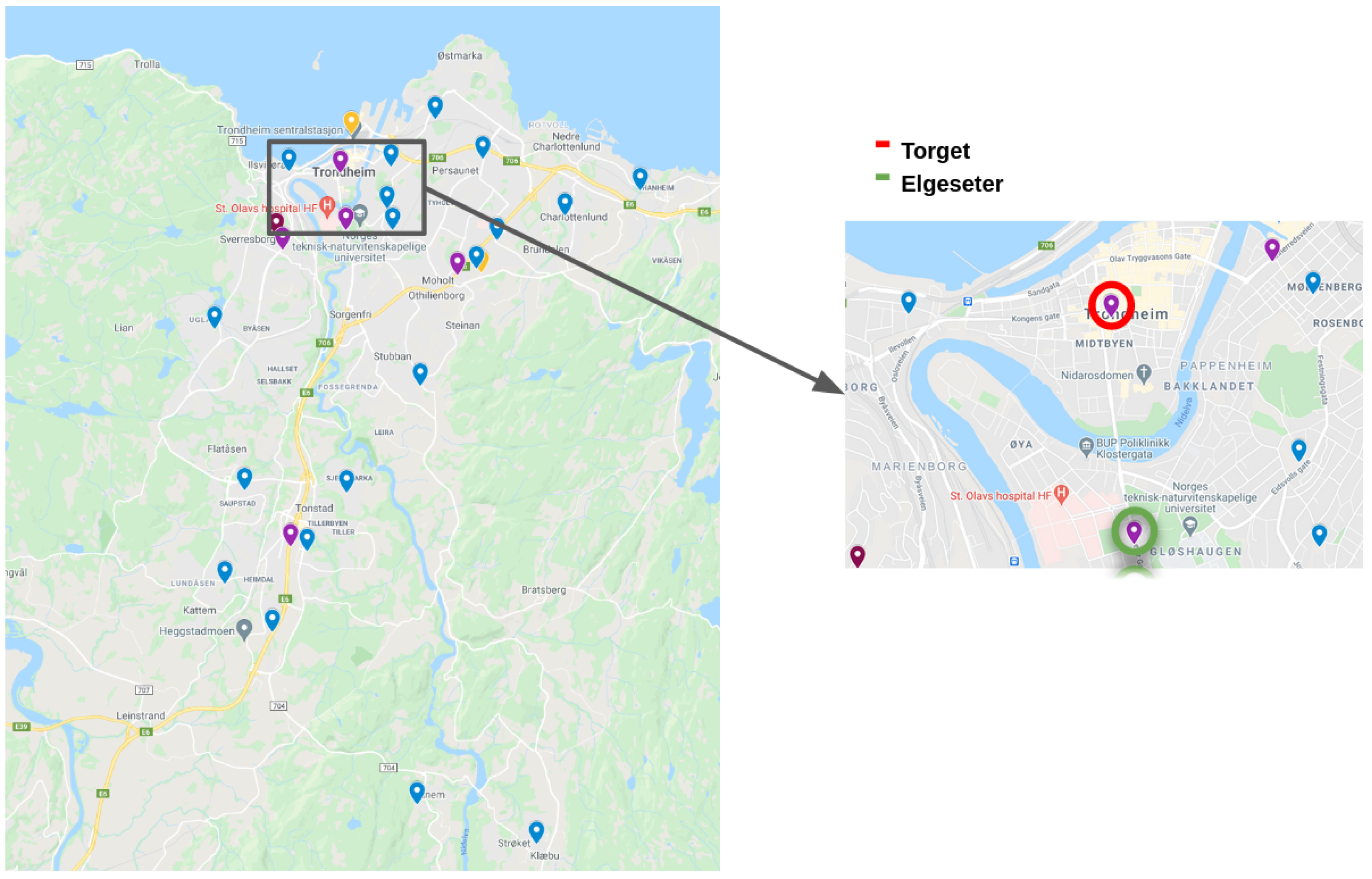
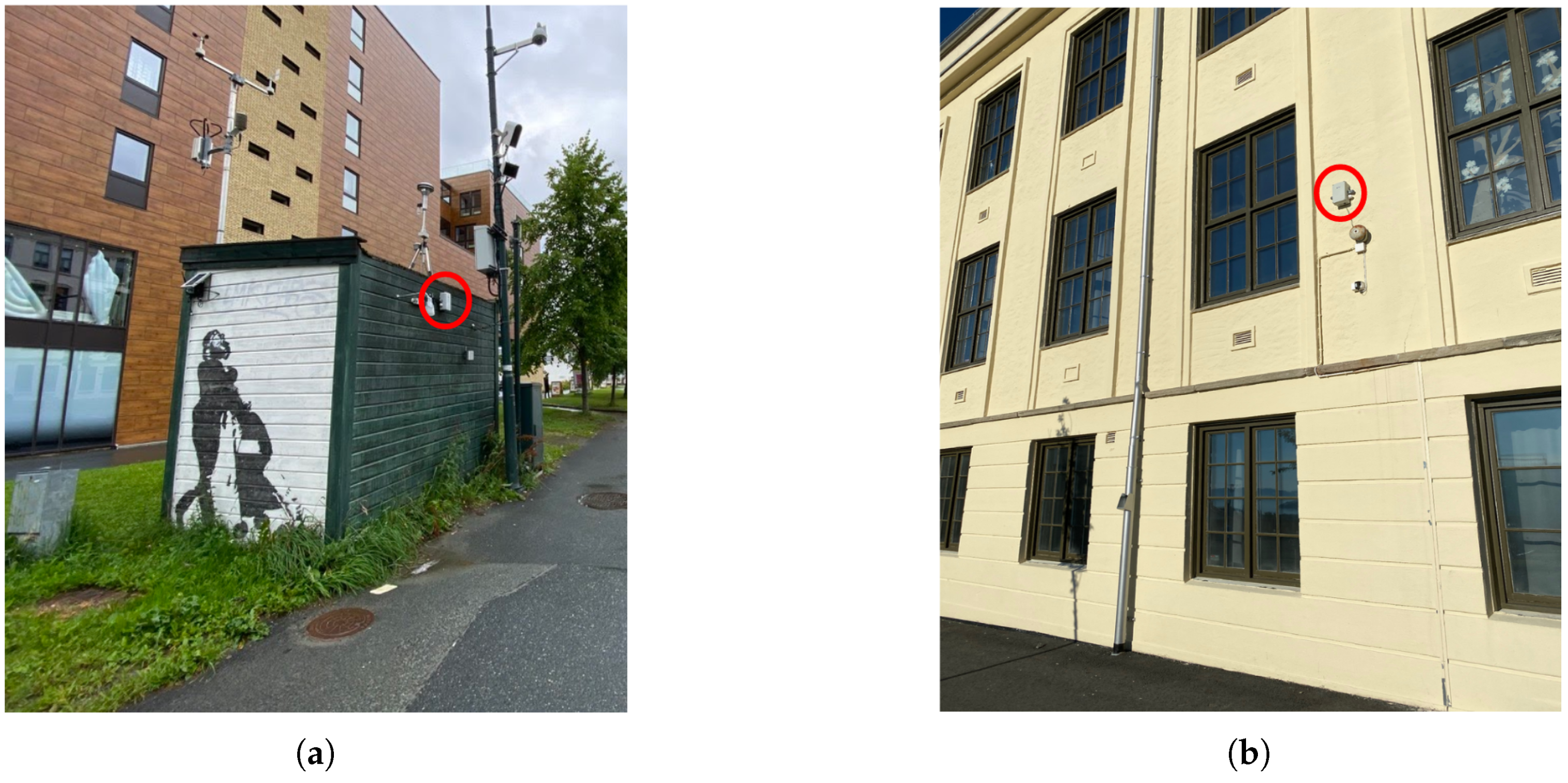
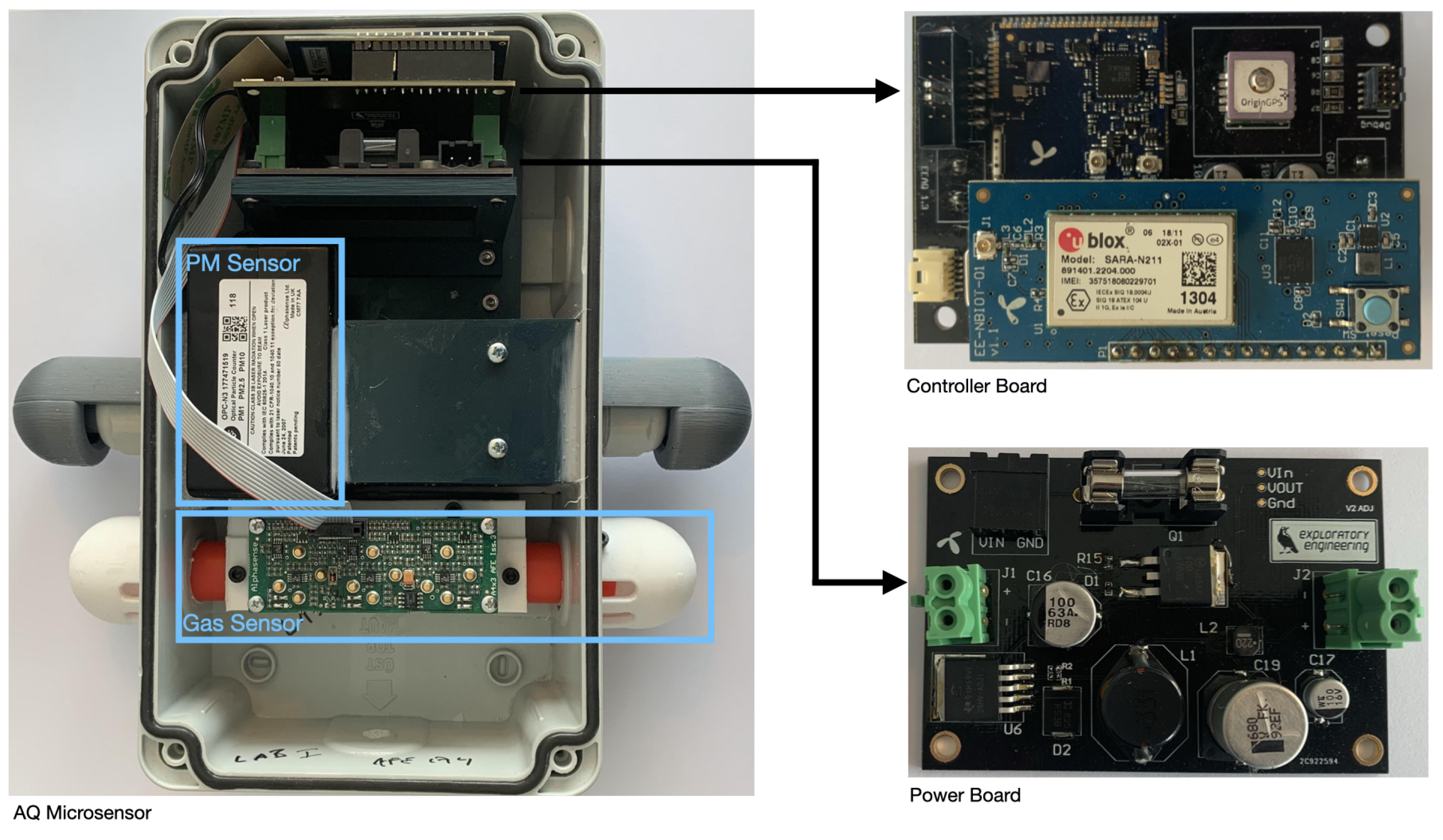
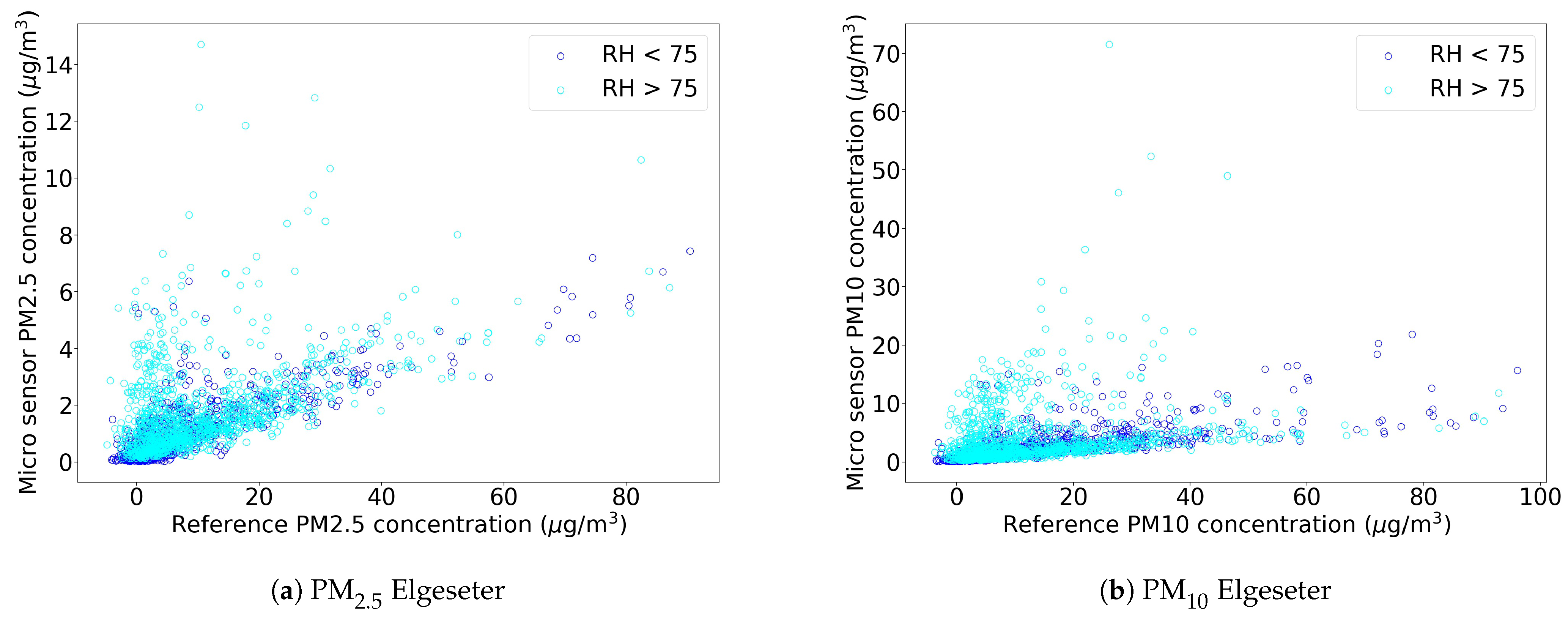
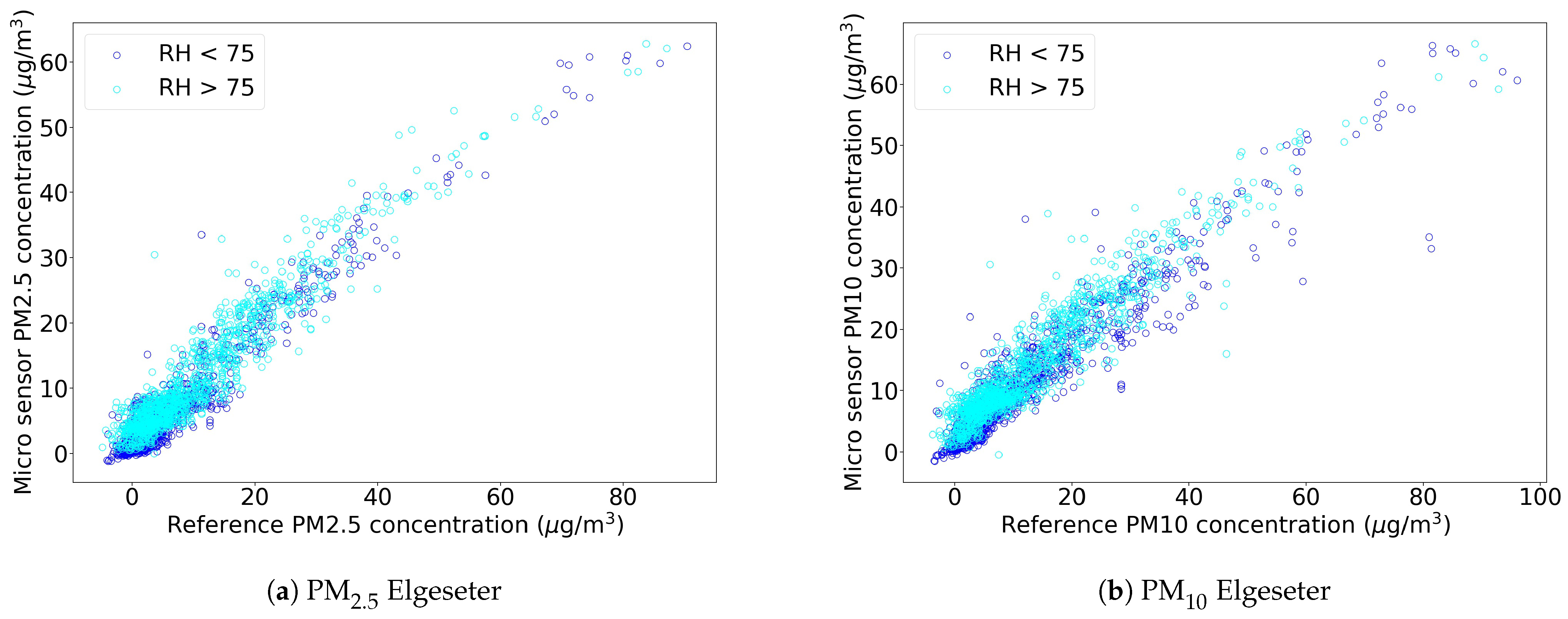
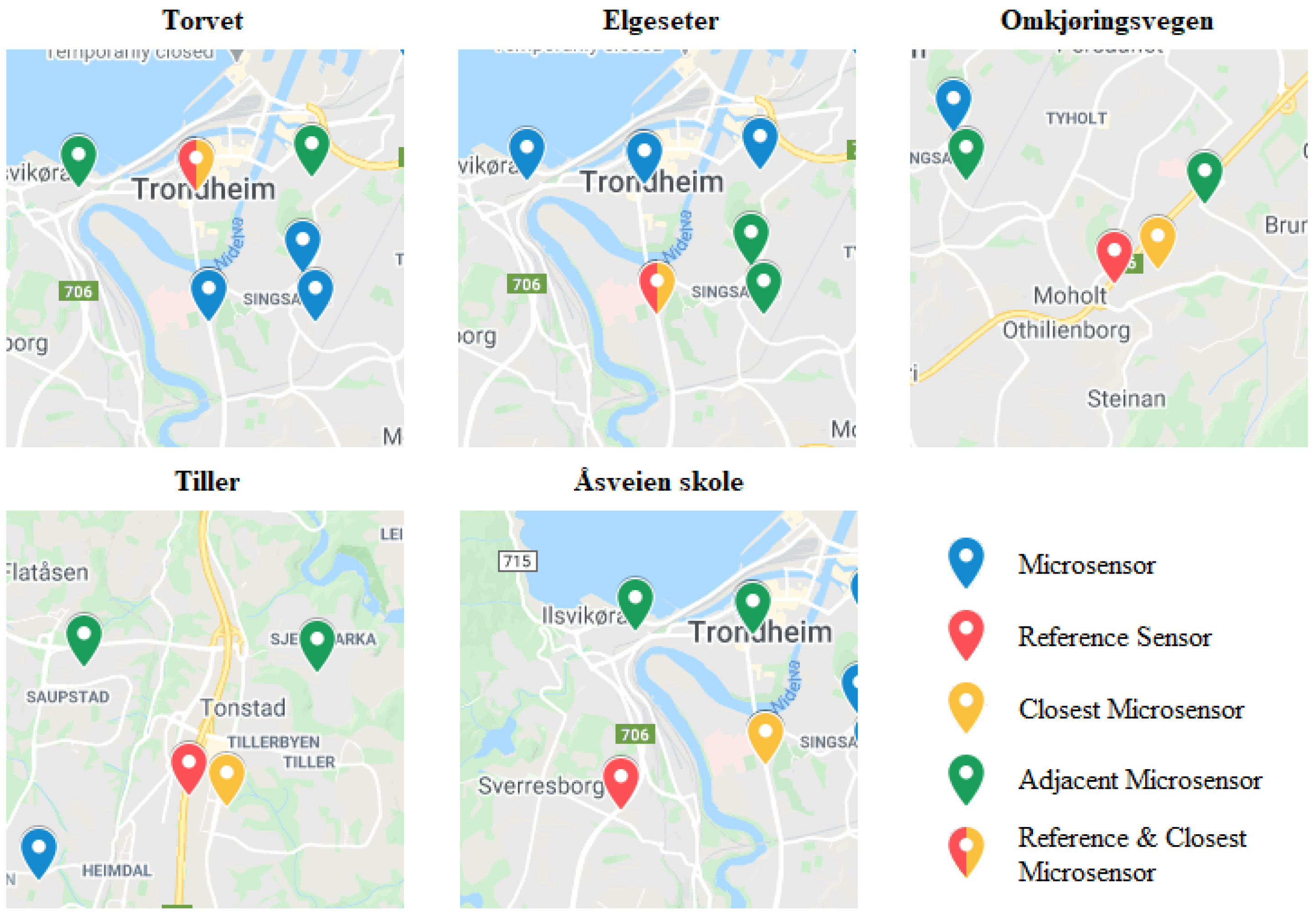
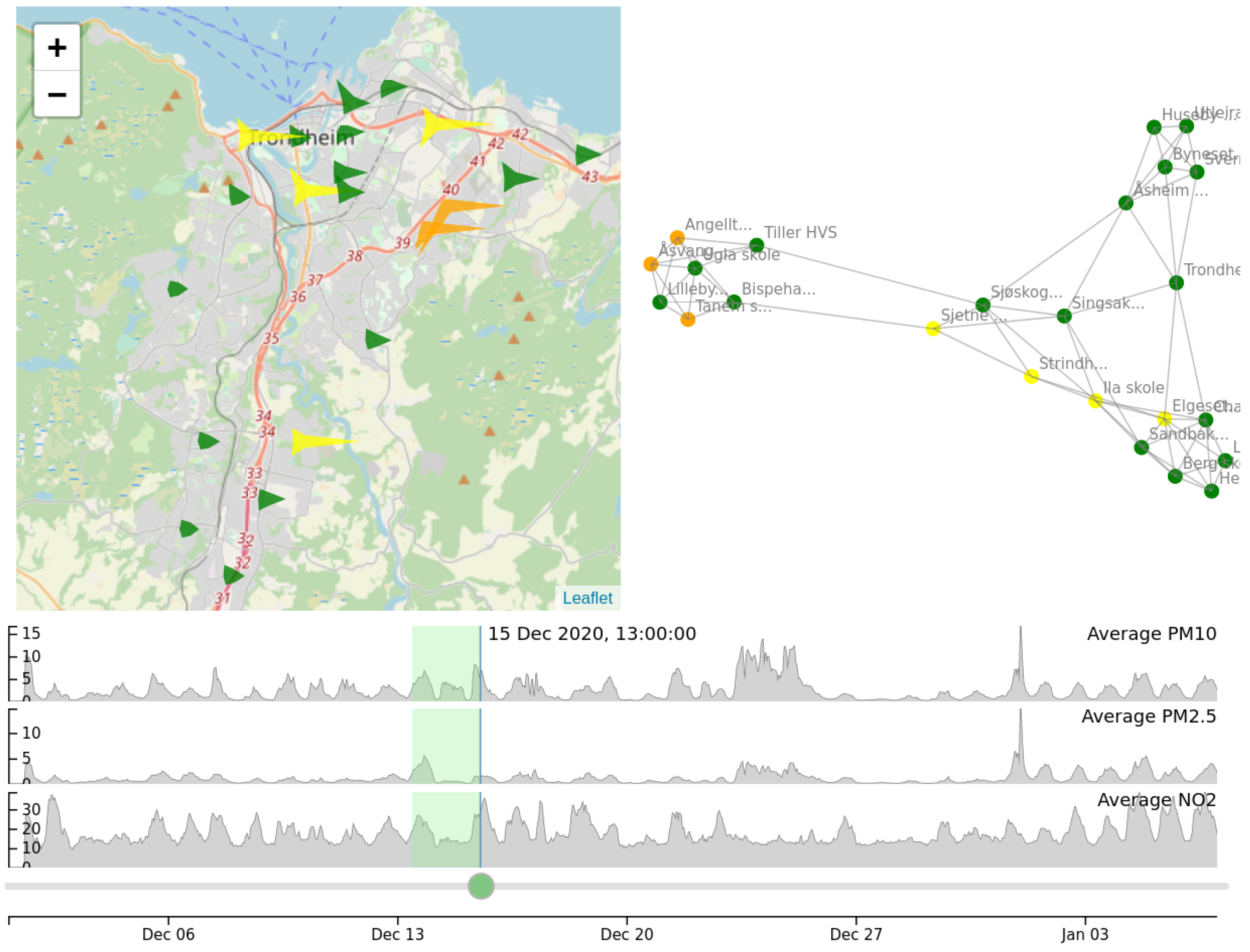
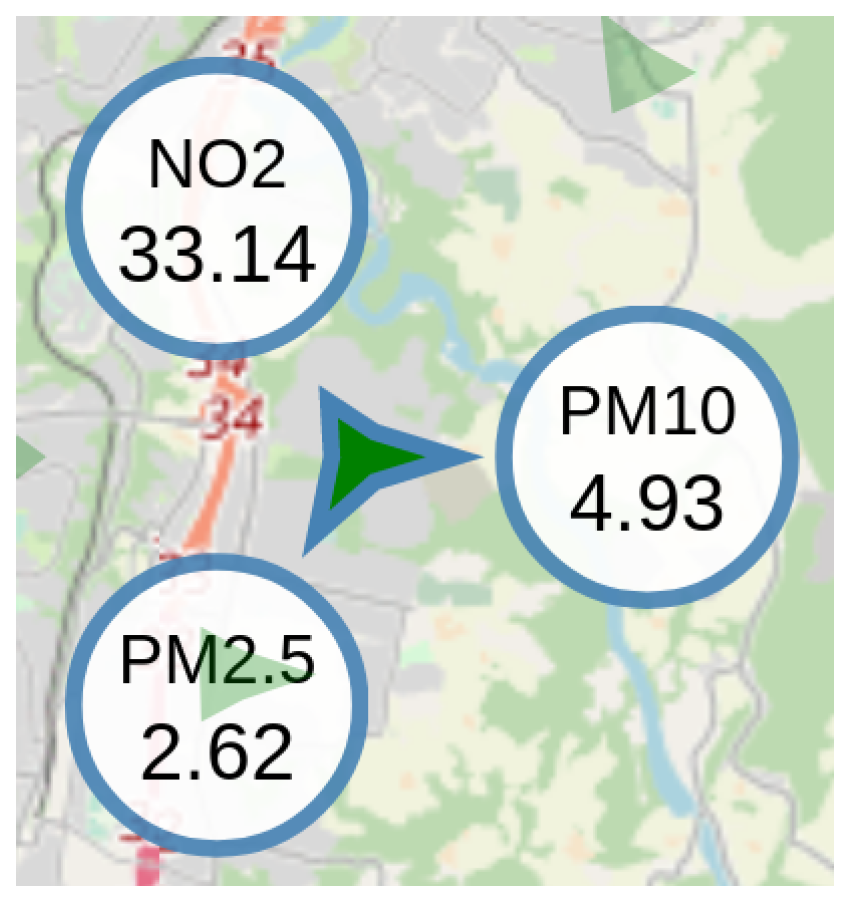
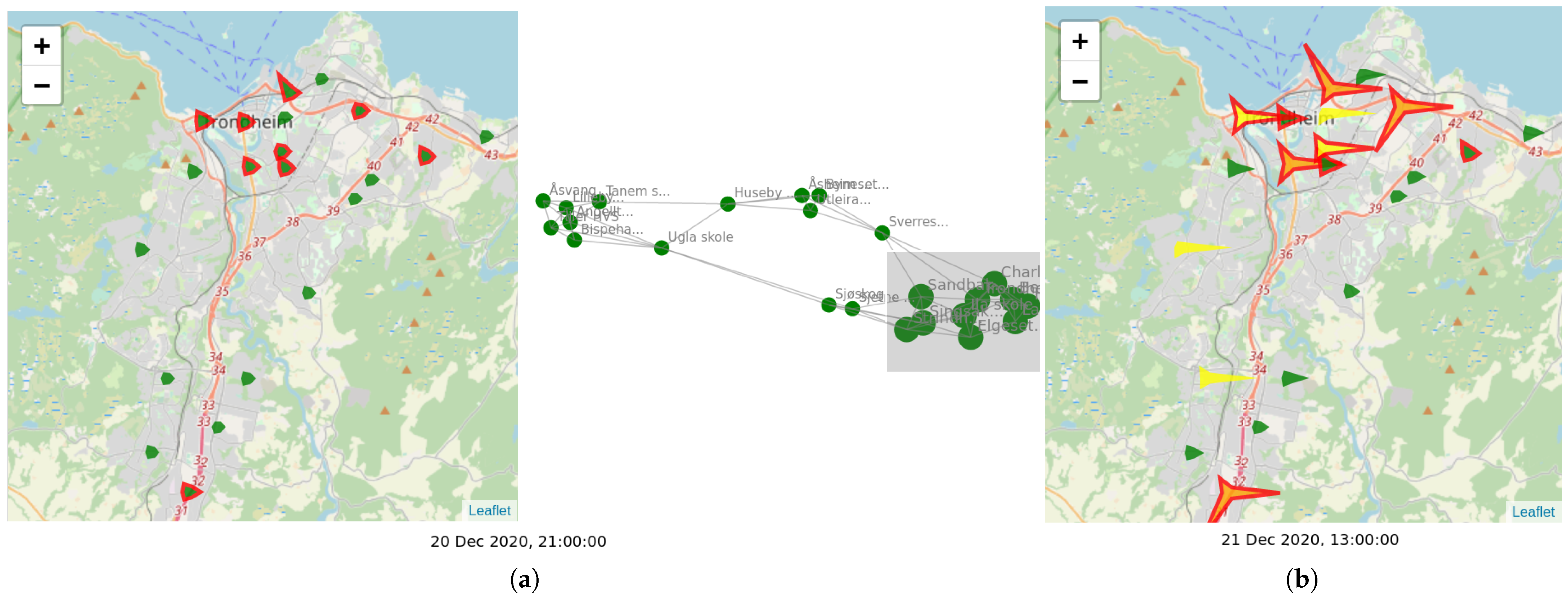
| Name | Measures | Detection Range (μm) | Num. Bins | Max Particle Count Rate | Max Coincidence Probability |
|---|---|---|---|---|---|
| Alphasense OPC-N3 | PM1 PM2.5 PM10 | 0.35–40 | 24 | 10,000 | at particles/L |
| (a) Data statistics. The count field is the total number of valid readings, while the other fields are in μg/m3. | ||||||||
| Elgeseter | Torget | |||||||
| Reference | Low-Cost | Reference | Low-Cost | |||||
| PM2.5 | PM10 | PM2.5 | PM10 | PM2.5 | PM10 | PM2.5 | PM10 | |
| count | 2314 | 2314 | 2344 | 2344 | 2340 | 2340 | 2345 | 2345 |
| mean | 9.09 | 12.88 | 1.43 | 3.26 | 9.06 | 11.45 | 1.11 | 2.00 |
| std | 11.73 | 13.67 | 1.46 | 4.28 | 10.64 | 12.57 | 1.02 | 1.86 |
| min | −4.81 | −3.80 | 0.00 | 0.00 | 0.10 | 0.10 | 0.02 | 0.04 |
| Q1 | 1.86 | 3.84 | 0.45 | 0.97 | 2.50 | 3.10 | 0.39 | 0.72 |
| median | 4.92 | 8.17 | 0.98 | 1.94 | 5.00 | 6.70 | 0.82 | 1.45 |
| Q3 | 12.16 | 17.94 | 1.87 | 3.73 | 11.30 | 15.00 | 1.50 | 2.64 |
| max | 90.44 | 96.10 | 14.70 | 71.48 | 83.40 | 135.10 | 10.33 | 13.72 |
| (b) Pearson correlation (r), slope and intercept between low-cost sensor and reference. | ||||||||
| Sensor Location | Particle Size | Slope + Intercept | ||||||
| Elgeseter | PM2.5 | 0.61 | ||||||
| PM10 | ||||||||
| Torget | PM2.5 | |||||||
| PM10 | ||||||||
| (a) Calibration with a random forest regressor. Data collected between 15 November 2020 and 23 February 2021. Train–test split: . | ||||||
| Inputs | Training | Test (Elgeseter) | Test (Torget) | |||
| RMSE | R2 | RMSE | R2 | RMSE | R2 | |
| Elgeseter, PM2.5 | ||||||
| PM2.5 | ||||||
| PM2.5, Temperature (OPC), Humidity (OPC) | ||||||
| PM2.5, Temperature, Humidity | ||||||
| PM2.5, Weather | ||||||
| PM1, PM2.5, PM10, Weather | ||||||
| PM1, PM2.5, PM10, Weather, Traffic | ||||||
| PM1, PM2.5, PM10, Weather, Hour of Day, Day of week | ||||||
| Elgeseter, PM10 | ||||||
| PM10 | ||||||
| PM10, Temperature (OPC), Humidity (OPC) | ||||||
| PM10, Temperature, Humidity | ||||||
| PM10, Weather | ||||||
| PM1, PM2.5, PM10, Weather | ||||||
| PM1, PM2.5, PM10, Weather, Traffic | ||||||
| PM1, PM2.5, PM10, Weather, Hour of Day, Day of week | ||||||
| (b) Calibration with a random forest classifier. Data collected between 15 November 2020 and 23 February 2021. Threshold of for PM2.5 and for PM10. Train–test split: . | ||||||
| Inputs | Test (Elgeseter) | Test (Torget) | ||||
| Recall | Precision | AUC | Recall | Precision | AUC | |
| Elgeseter, PM2.5 | ||||||
| PM2.5 | ||||||
| PM2.5, Temperature (OPC), Humidity (OPC) | ||||||
| PM2.5, Temperature, Humidity | ||||||
| PM2.5, Weather | ||||||
| PM1, PM2.5, PM10, Weather | ||||||
| PM1, PM2.5, PM10, Weather, Traffic | ||||||
| PM1, PM2.5, PM10, Weather, Hour of Day, Day of week | ||||||
| Elgeseter, PM10 | ||||||
| PM10 | ||||||
| PM10, Temperature (OPC), Humidity (OPC) | ||||||
| PM10, Temperature, Humidity | ||||||
| PM10, Weather | ||||||
| PM1, PM2.5, PM10, Weather | ||||||
| PM1, PM2.5, PM10, Weather, Traffic | ||||||
| PMPM1, PM2.5, PM10, Weather, Hour of Day, Day of week | ||||||
| (a) Data statistics. The count field is the total number of valid readings, while the other fields are in μg/m3. | ||||||||
| Elgeseter | Torget | |||||||
| Reference | Low-Cost | Reference | Low-Cost | |||||
| PM2.5 | PM10 | PM | PM | PM2.5 | PM10 | PM | PM | |
| count | 2314 | 2314 | 2344 | 2344 | 2340 | 2340 | 2345 | 2345 |
| mean | 9.09 | 12.88 | 9.63 | 12.95 | 9.06 | 11.45 | 8.66 | 10.96 |
| std | 11.73 | 13.67 | 9.86 | 10.45 | 10.64 | 12.57 | 9.00 | 9.32 |
| min | −4.81 | −3.80 | −1.23 | −1.54 | 0.10 | 0.10 | −1.18 | −1.33 |
| Q1 | 1.86 | 3.84 | 3.52 | 6.12 | 2.50 | 3.10 | 3.11 | 5.27 |
| median | 4.92 | 8.17 | 6.33 | 9.54 | 5.00 | 6.70 | 5.83 | 8.12 |
| Q3 | 12.16 | 17.94 | 12.10 | 17.48 | 11.30 | 15.00 | 9.92 | 14.05 |
| max | 90.44 | 96.10 | 62.79 | 66.59 | 83.40 | 135.10 | 62.73 | 65.46 |
| (b) Pearson correlation (r), slope and intercept between calibrated low-cost sensors and reference. | ||||||||
| Sensor Location | Particle Size | Slope + Intercept | ||||||
| Elgeseter | PM2.5 | |||||||
| PM10 | ||||||||
| Torget | PM2.5 | |||||||
| PM10 | ||||||||
| Models | Training Set | Test Set | ||
|---|---|---|---|---|
| RMSE | R2 | RMSE | R2 | |
| PM2.5 Prediction | ||||
| Random Forest Regressor | ||||
| Closest low-cost sensor value | ||||
| Closest 3 low-cost sensors avg value | ||||
| PM10 Prediction | ||||
| Random Forest Regressor | ||||
| Closest low-cost sensor value | ||||
| Closest 3 low-cost sensors avg value | ||||
| Inputs | Test (w/Low-Cost Sensor) | Test (w/NEA) | ||||
|---|---|---|---|---|---|---|
| Recall | Precision | AUC | Recall | Precision | AUC | |
| Elgeseter, PM2.5 | ||||||
| Pollutants | ||||||
| Pollutants, Weather | ||||||
| Pollutants, Weather, Traffic | ||||||
| Pollutants, Weather, Traffic, Temporal | ||||||
| Pollutants, Weather, Traffic, Temporal, Delta | ||||||
| Pollutants, Weather, Traffic, Temporal, Delta, Forecast | ||||||
| Elgeseter, PM10 | ||||||
| Pollutants | ||||||
| Pollutants, Weather | ||||||
| Pollutants, Weather, Traffic | ||||||
| Pollutants, Weather, Traffic, Temporal | ||||||
| Pollutants, Weather, Traffic, Temporal, Delta | ||||||
| Pollutants, Weather, Traffic, Temporal, Delta, Forecast | ||||||
Publisher’s Note: MDPI stays neutral with regard to jurisdictional claims in published maps and institutional affiliations. |
© 2021 by the authors. Licensee MDPI, Basel, Switzerland. This article is an open access article distributed under the terms and conditions of the Creative Commons Attribution (CC BY) license (https://creativecommons.org/licenses/by/4.0/).
Share and Cite
Veiga, T.; Munch-Ellingsen, A.; Papastergiopoulos, C.; Tzovaras, D.; Kalamaras, I.; Bach, K.; Votis, K.; Akselsen, S. From a Low-Cost Air Quality Sensor Network to Decision Support Services: Steps towards Data Calibration and Service Development. Sensors 2021, 21, 3190. https://doi.org/10.3390/s21093190
Veiga T, Munch-Ellingsen A, Papastergiopoulos C, Tzovaras D, Kalamaras I, Bach K, Votis K, Akselsen S. From a Low-Cost Air Quality Sensor Network to Decision Support Services: Steps towards Data Calibration and Service Development. Sensors. 2021; 21(9):3190. https://doi.org/10.3390/s21093190
Chicago/Turabian StyleVeiga, Tiago, Arne Munch-Ellingsen, Christoforos Papastergiopoulos, Dimitrios Tzovaras, Ilias Kalamaras, Kerstin Bach, Konstantinos Votis, and Sigmund Akselsen. 2021. "From a Low-Cost Air Quality Sensor Network to Decision Support Services: Steps towards Data Calibration and Service Development" Sensors 21, no. 9: 3190. https://doi.org/10.3390/s21093190
APA StyleVeiga, T., Munch-Ellingsen, A., Papastergiopoulos, C., Tzovaras, D., Kalamaras, I., Bach, K., Votis, K., & Akselsen, S. (2021). From a Low-Cost Air Quality Sensor Network to Decision Support Services: Steps towards Data Calibration and Service Development. Sensors, 21(9), 3190. https://doi.org/10.3390/s21093190








